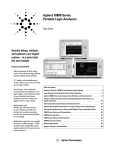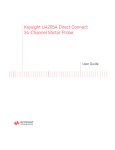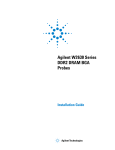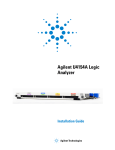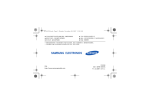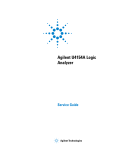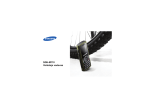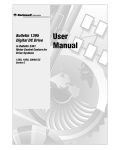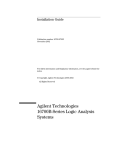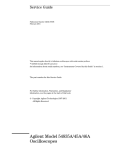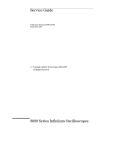Download Agilent Technologies E5864A Specifications
Transcript
Agilent 16850 Series Portable Logic Analyzers Data Sheet The industry’s fastest timing capture with deep memory ― for fast digital system debug • 2.5 GHz timing capture with up to 128 M sample memory for finding elusive problems quickly, even far from the trigger point • Up to 1.4 GHz trigger sequencer speed for state and timing capture • Single-ended and differential probing for the widest range of supported technologies 16850 Series Portable Logic Analyzer Selection Guide • 80 ps resolution (12.5 GHz) Timing Zoom with 256 K samples allows you to observe signal timing in proximity to the trigger point • Up to 1.4 Gbps state data rate tracks high speed parallel and serial buses in your design • Gain signal integrity insight on all channels using exclusive “eye scan” • Four models with 34/68/102/136 channels provide the measurement flexibility for a wide range of applications • Application support for many aspects of today’s complex designs bring target insight FPGA dynamic probe, and digital VSA (vector signal analysis) • Powerful, customizable triggering quickly isolates problems • Proven, easy to use interface speeds debug • Standard 15 inch touch screen allows viewing of multiple buses and signals • Standard 3-year warranty Specifications and characteristics Channels Maximum timing sample rate (half/full channel) High-speed timing zoom Trigger sequencer Maximum state clock rate Maximum state data rate Maximum memory depth Supported signal types Automated threshold/sample position Simultaneous eye diagrams, all channels Probe compatibility 2 16851A 16852A 16853A 16854A 34 68 102 136 5 GHz (200 ps) with up to 256 M depth 2.5 GHz (400 ps) with up to 128M depth 12.5 GHz (80 ps) with 256 Kb depth 1.4 GHz 700 MHz with Option 700 350 MHz standard 1400 Mb/s with Option 700 700 Mb/s standard 2 M default 4 M with Option 004 8 M with Option 008 16 M with Option 016 32 M with Option 032 64 M with Option 064 128 M with Option 128 Single-ended, differential Yes Yes Direct connect single-ended flying lead Mictor and Soft Touch Pro connectorless 90-pin connector single-ended and differential probes for flying lead, Mictor, Soft Touch, Soft Touch Pro, and Samtec connections (used in conjunction with a U4201A cable) Select DDR2/3 BGA probes and probe cables Select DDR3 Addr/Cmd slot interposer probes Industry’s Fastest Timing Capture with Deep Memory ― for Fast Digital System Debug Agilent 16850 Series portable logic analyzers offer the highest performance, with deep, high speed timing and state measurements, combined with the applications and usability your digital development teams need to debug their modern systems ― and at a great price. Figure 1. With four models to choose from, and options to upgrade state speed and memory depth, you can get a logic analyzer with measurement capabilities that meet your needs. The logic analyzer’s timing and state acquisition gives you the power to: Automate the capture of internal FPGA signals • Observe timing relationships far away from the trigger point using 2.5 GHz (400 ps)/5 GHz (200 ps) full/half channel timing with up to 128 M samples • Measure more precise timing relationships in the vicinity of the trigger point using 12.5 GHz (80 ps) Timing Zoom (256 K samples) • Find anomalies separated in time with memory depths upgradable to 128 M • Probe a variety of technologies with single-ended and differential attachment options with the highest signal integrity • Buy what you need today and upgrade in the future. 16850 Series logic analyzers come with independent upgrades for state speed and memory depth • Sample synchronous buses up to 1400 Mbps data rates accurately using eye scan to automatically adjust threshold and setup/hold • Easily track problems from symptom to root cause across several measurement modes by viewing time-correlated data in waveform/chart, listing, inverse assembly, source code, or compare display • Identify potential signal integrity issues on high data rate signals by observing an analog view of all input channels via logic analyzer probing with “eye scan” • Set up triggers quickly and confidently with intuitive, “simple,” “quick,” and “advanced” triggering options • Time correlate and import oscilloscope/mixed-signal traces into the logic analyzer Waveform window for even greater system insight 16850 Series logic analyzers, used with the FPGA Dynamic Probe, let you probe internal FPGA nets on Xilinx and Altera devices with deep memory and through an automated process 3 • No block RAM required • Move probe points without stopping the FPGA or changing design timing • Import signal names automatically from the FPGA design • Automatically map FPGA pins to logic analyzer input channels (Xilinx) • B4655A (Xilinx) B4656A (Altera) Decode DDR2/3 memory Addr/Cmd buses and perform compliance and performance analysis Eye Scan to Set Sample Points and to View Signal Integrity Automate measurement setup and quickly gain diagnostic clues 16850 Series logic analyzers make it easy for you to get up and running quickly by automating your measurement setup process. In addition, the logic analyzer’s setup/hold window (or sampling position) and threshold voltage settings are automatically determined so you can capture data on high-speed buses with the highest accuracy. Auto Threshold and Sample Position mode allow you to... • Obtain accurate and reliable measurements • Save time during measurement setup • Gain diagnostic clues and identify problem signals quickly • Scan all signals and buses simultaneously or just a few • View results as a composite display or as individual signals • See skew between signals and buses • Find and fix inappropriate clock thresholds • Measure data valid windows • Identify signal integrity problems related to rise times, fall times, data valid window widths Figure 2. Eye scan automatically sets sample positions for accurate state capture and also provides a signal integrity view of each input signal, without the need for an oscilloscope. Identify problem signals over one hundred channels simultaneously As timing and voltage margins continue to shrink, confidence in signal integrity becomes an increasingly vital requirement in the design validation process. Eye scan lets you acquire signal integrity information on all the buses in your design, under a wide variety of operating conditions, in a matter of minutes. Identify problem signals quickly for further investigation with an oscilloscope. Results can be viewed for each individual signal or as a composite of multiple signals or buses. 4 16850 Series Logic Analyzer Specifications and Characteristics Number of channels 16851A 34 (1 clock + 1 clock qualifier) 16852A 68 ( 1 clock + 3 clock qualifiers) Deep timing (asynchronous) sampling mode 16853A 102 (1 clock + 3 clock qualifiers) 16854A 136 (1 clock + 3 clock qualifiers) Conventional and transitional timing (up to 128 M depth) Maximum sample rate in full channel mode (nom) Maximum sample rate in half channel mode (nom) Sample period on all channels (nom) Sample period in half channel mode (nom) Minimum data pulse width (nom) Maximum time between transitions (nom) Time interval accuracy within a 16 channel pod (typ) 1 Time interval accuracy across 16 channel pods (typ) 1 2.5 GHz 5 GHz 400 ps to 10 ns 200 ps 1 sample period + 200 ps 66 days ± (1 sample period + 130 ps + 0.01% of time interval reading) ± (1 sample period + 400 ps + 0.01% of time interval reading) 1. With single-ended flying lead and Soft Touch Pro probes. Timing zoom (captured simultaneously with timing or state sampling mode capture) Timing analysis sample rate (nom) Time interval accuracy (nom) Within a 16 channel block Between 16 channel blocks Memory depth (nom) Trigger position (nom) Minimum data pulse width (nom) 12.5 GHz (80 ps sample resolution) ± (80 ps + 130 ps + 0.01% of time interval reading) ± (80 ps + 400 ps + 0.01% of time interval reading) 256 K samples Start, center, end, or user-defined 1 sample period + 200 ps State (synchronous) sampling mode Maximum state data rate ― base (spec) Maximum state data rate ― Option 700 (spec) Maximum state clock frequency ― single edge clocking ― base (typ) Maximum state clock frequency ― single edge clocking ― Option 700 (typ) Minimum state clock frequency (typ) 1 Minimum data valid window (typ) 2 Sample position adjustment resolution (typ) Sample position adjustment accuracy (typ) Minimum data valid window (typ) 1 Minimum setup time (typ) Minimum hold time (typ) Minimum eye height (typ) Sample position adjustment range (typ) Minimum state clock pulse width single edge (typ) Minimum time between active clock edges ― standard (typ) Minimum time between active clock edges ― Option 700 (typ) Maximum time between active clock edges (typ) 1 Clock qualifier setup time (typ) Clock qualifier hold time (typ) Time tag resolution (typ) Maximum time count between stored states (nom) 1. Clock can pause for up to 66 days once every 8 or more edges. 2. Dependent on probing system. 5 700 Mb/s using both edges of clock (spec) 1.4 Gb/s using both edges of clock (spec) 350 MHz 700 MHz 12.5 MHz (single edge) 6.25 MHz (both edges) 160 ps 20 ps ± 150 ps 160 ps 80 ps 80 ps 160 mV 7 ns 200 ps 1429 ps 714 ps 80 ns (single edge) 200 ps 200 ps 80 ps 66 days 16850 Series Logic Analyzer Specifications and Characteristics (continued) Trigger characteristics (conventional timing, transitional timing, and state sampling modes) Maximum trigger sequence speed (standard) (nom) Maximum trigger sequence speed (option 700) (nom) Maximum trigger sequence levels (nom) Trigger sequence level branching (nom) Trigger position (nom) Trigger resources (nom) Maximum occurrence counter (nom) Maximum pattern width (nom) Maximum range width (nom) Timers range (nom) Timer resolution (nom) Timer accuracy (typ) Timer reset latency (nom) 700 MHz (state), 1.4 GHz (timing) 1.4 GHz 8 Arbitrary 4-way if/then/else Start, center, end or user-defined 16 patterns evaluated as =, !=, >, >=, <, <= 8 double-bounded ranges evaluated as in range, not in range 4 edge detectors in timing, 3 in transitional timing 1 occurrence counter per sequence level 1 timer 3 flags 1 arm in Arbitrary Boolean combinations Go To Trigger and fill memory Trigger and Go To Trigger, send e-mail, and fill memory Occurrence counter reset Default (global) and per sequence level Store/don’t store sample Turn on/off default storing Start from reset Stop and reset Pause Resume Set Clear Pulse set Pulse clear 999,999,999 128 bits – single label 64 bits 200 * sample clock period to 27 hours 5 ns ± (8 * sample clock period + 2ns + 0.01%) 80 * sample clock period Input signal amplitude Vamptd (typ) Supported signal types Voltage threshold (typ) Threshold resolution (typ) Threshold accuracy (typ) Threshold setting granularity ≥ 350 mV Single-ended and differential –5 V to +5 V 2 mV ± (30 mV + 1% of setting) Individual threshold for each channel Trigger resource Boolean conditions (nom) Trigger actions (nom) Store qualification actions (nom) Timer actions Flag actions General 1. Specification (spec): Represents warranted performance of a calibrated instrument that has been stored for a minimum of 2 hours within the operating temperature range of 0 to 40 °C, unless otherwise stated, and after a 45-minute warm-up period. The specifications include measurement uncertainty. 2. Typical (typ): Represents characteristic performance, which 80% of the instruments manufactured will meet. This data is not warranted, does not include measurement uncertainty, and is valid only at room temperature (approximately 25 °C). 3. Nominal (nom): The expected mean or average performance, or an attribute whose performance is by design, such as the 50 Ω connector. This data is not warranted and is measured at room temperature (approximately 25 °C). 4. Measured (meas): An attribute measured during the design phase for purposes of communicating expected performance, such as amplitude drift versus time. This data is not warranted and is measured at room temperature (approximately 25 °C). 6 Unleash the Complementary Power of a Logic Analyzer and an Oscilloscope Seamless oscilloscope integration with View Scope Easily make time-correlated measurements between Agilent logic analyzers and oscilloscopes. The time-correlated logic analyzer and oscilloscope waveforms are integrated into a single logic analyzer waveform display for easy viewing and analysis. You can also trigger the oscilloscope from the logic analyzer (or vice versa), automatically de-skew the waveforms and maintain marker tracking between the two instruments. View Scope allows you to perform the following more effectively: • Validate signal integrity • Track down problems caused by signal integrity • Validate correct operation of A/D and D/A converters • Validate correct logical and timing relationships between the analog and digital portions of a design Connection The Agilent logic analyzer and oscilloscope can be physically connected with standard BNC and LAN connections. Two BNC cables are connected for cross triggering, and the LAN connection is used to transfer data between the instruments. The View Scope correlation software is standard in the logic analyzer’s application software version 3.50 or higher. The View Scope software includes: • Ability to import some or all of the captured oscilloscope waveforms • Auto scaling of the scope waveforms for the best fit in the logic analyzer display Figure 3. View Scope seamlessly integrates your scope and logic analyzer waveforms into a single display. Feature Benefit Automated setup Integrated waveform display Automatic measurement de-skew Cross trigger the logic analyzer and oscilloscope Tracking markers 7 Quickly get to your first measurement using the logic analyzer’s Help wizard for easy setup, regardless of which supported Agilent oscilloscope you connect to. Instantly validate the logical and timing relationships between the analog and digital portions of your design. View oscilloscope and logic analyzer waveforms integrated into a single logic analyzer waveform display. Save time and gain confidence in measurement results with measurements that are automatically de-skewed in time. Start your debug approach from either the analog or digital domain with the flexibility to trigger the oscilloscope from the logic analyzer (or vice versa). Precisely relate information on the oscilloscope’s display to the corresponding point in time on the logic analyzer display with tracking markers. The oscilloscope’s time markers automatically track adjustments of the logic analyzer’s global markers. Get Instant Insight into your Design with Multiple Views and Analysis Tools Acquisition and analysis tools provide rapid insight into your toughest debug problems When you want to understand what your target is doing and why, you need acquisition and analysis tools that rapidly consolidate data and provide insight into your system’s behavior. Figure 4. Perform in-depth time, frequency and modulation domain analysis on your digital baseband and IF signals with Agilent’s 89600 Vector Signal Analysis software, running on the logic analyzer. Optional analysis and automated measurement packages B4655A FPGA Dynamic Probe (Xilinx), B4656A FPGA Dynamic Probe (Altera) Gain unprecedented visibility into your FPGA’s internal activity. Make incremental real-time measurements in seconds without stopping the FPGA, changing the design or modifying design timing. Quickly set up the logic analyzer with automatic pin mapping and signal bus naming by leveraging work you did in your design environment. www.agilent.com/find/fpga 89601B-300 digital vector signal analysis, hardware Perform time-domain, spectrum, and modulation quality analysis on digital connectivity for logic analyzers Baseband and IF signals. www.agilent.com/find/dvsa B4601C serial-to-parallel analysis package Eliminate the tedious, time-consuming, and error-prone task of sifting through thousands of analysis package serial bits by looking at long vertical columns of captured 1’s and 0’s. The B4601C serial-to-parallel analysis package is general-purpose software that allows easy viewing and analysis of serial data. B4602A signal extractor tool This tool processes input signals and based on xml algorithms and creates a mapping of captured signals into new bus and signal names B4606A advanced customization environment— Tailor your logic analyzer interface with a wide range of control, analysis development and runtime package and display capabilities specific to your measurement application. Create integrated dialogs, graphical displays and analysis functions to quickly manipulate measurement data into a format that provides additional insight and answers. www.agilent.com/find/logic-customview B4607A advanced customization environment— Run the macros and graphical views created with a B4606A development runtime package package or obtain and run a variety of commonly requested tools from Agilent and its partners to help customize your measurement environment. B4608A ASCII remote programming interface Remotely control a 16850-Series logic analysis system by issuing ASCII commands. This interface is designed to be as similar as possible to the RPI on the 16700 Series logic analysis system, so that you can reuse existing programs. Requires either B4606A or B4607A to be enabled. You can also use the B4606A to customize and add RPI commands. B4610A data import package Use the logic analyzer GUI to view data obtained from tools other than a logic analyzer. B4630A MATLAB® connectivity and analysis package Make an easy connection to MATLAB and transfer your logic analyzer measurement data for processing. Display the results on the logic analyzer in an XY scattergram chart. 8 Validate your DDR2 and DDR3 Memory Systems The state analysis capabilities of the 16850 Series allow it to make measurements and analysis on DDR2 and DDR3 memories up to DDR2/3 1333 (667 MHz clock) on address and control lines. Memory bus decode, compliance testing, and performance analysis are available in state mode only with related orderable tools. Addr/Cmd only DDR2 memory DDR3 memory Up to DDR2 1333 (667 MHz clock) state measurements on Addr/Cmd only. (No Data) Up to DDR3 1333 (667 MHz clock) state measurements on Addr/Cmd only. (No Data) Requires 34 channel model or higher (one U4201A cable required providing two 90 pin pods) Related Orderable SW Tools (State mode only): • B4621B Bus Decoder for DDR, DDR2, DDR3, DDR4 Debug and Validation (Only DDR2 and DDR3 are supported with the 16850 Series logic analyzer.) • B4622B Protocol Compliance and Analysis Toolset for DDR/2/3/4, and LPDDR/2/3 (Only DDR2 and DDR3 are supported with the 16850 Series logic analyzer.) Supported probes with configuration files: Supported probes with configuration files: • x16 Addr/Cmd/Data DDR2 BGA probe (W2631B) (Requires E5384A ZIF probe) 1 • x16 Addr/Cmd/Data DDR3 BGA probe (W3631A) (Requires E5845A ZIF probe) 1 • x8 Addr/Cmd/Data DDR2 BGA probe (W2633B) (Requires E5384A ZIF probe) 1 • x8 Addr/Cmd/Data DDR3 BGA probe (W3633A) (Requires E5847A ZIF probe) 1 FS2372 DDR3 DIMM interposer (Addr/Cmd only) FS2374 DDR3 SODIMM interposer (Addr/Cmd only) Addr/Cmd/Data Up to DDR2 800 (400 MHz clock) timing measurements using 2.5 GHz timing analyzer with deep memory (for 3:1 ratio of sample rate to data rate) Up to DDR3 800 (400 MHz clock) timing measurements using 2.5 GHz timing analyzer with deep memory (for 3:1 ratio of sample rate to data rate) Requires 68 channel model or higher (two U4201A cables using three of the four 90 pin pods provided) Supported probes with configuration files: Supported probes with configuration files: • x16 Addr/Cmd/Data DDR2 BGA probe (W2631B) (Requires E5384A ZIF probe) • x16 Addr/Cmd/Data DDR3 BGA probe (W3631A) (Requires E5845A ZIF probe) • x8 Addr/Cmd/Data DDR2 BGA probe (W2633B) (Requires E5384A ZIF probe) • x8 Addr/Cmd/Data DDR3 BGA probe (W3633A) (Requires E5847A ZIF probe) For higher speed memory analysis or greater channel count refer to the U4154A logic analyzer module. 1. Data pod is not connected for State measurements when used with the 16850 Series. Simultaneous State mode capture of Read and Write data requires a U4154A high-performance logic analyzer module with dual sample mode. 9 Validate your DDR2 and DDR3 Memory Systems (continued) 16850 Series capture and decode of DDR3 Addr/Cmd lines Performance test analysis of DDR3 Addr/Cmd line saved trace Compliance test analysis of DDR3 Addr/Cmd line saved trace Figure 5. Multiple views for DDR2 and DDR3 Addr/Cmd capture. 10 Deep memory capture with 2.5 GHz (400 ps resolution) timing Figure 6. Timing mode capture with 400 ps resolution and up to 128 M samples memory depth (example capture at –500 μs before trigger). Powerful, customizable triggering with a 1.4 GHz sequencer Figure 7. Example of a time out trigger to capture an error condition. 11 16850 Series Instrument Characteristics Standard data views Waveform Listing Compare Source code Eye scan Data display Numeric bases for data display Integrated display of data as digital waveforms, analog waveforms imported from an external oscilloscope, and/or as a chart of a bus’ values over time Displays data as a state listing Compares data from different acquisitions and highlights differences Displays time-correlated source code and inverse assembly simultaneously in a split display Define the trigger event by simply clicking on a line of source code Obtain source-code-level views of dynamically loaded software or code moved from ROM to RAM during a boot-up sequence using address offsets Requires access to source files via the LAN or instrument hard drive to provide source code correlation Source correlation does not require any modification or recompilation of your source code Displays eye diagrams across all buses and signals simultaneously, allowing you to identify problem signals quickly Binary, hex, octal, decimal, signed decimal (two’s complement), ASCII, symbols, and processor mnemonics Symbolic support/object file format compatibility Number of symbols/ranges Object file formats supported ASCII User defined symbols Available data/file formats ala xml csv mfb Standard analysis tools Filter/colorize Find (next/previous) Unlimited (limited only by amount of virtual memory available on 16850 Series logic analyzers) IEEE-695, Aout, Omf86, Omf96, Omf386, Sysrof, ELF/DWARF1 1, ELF/DWARF2 1, ELF/ Stabs1, ELF/Stabs2, ELF/Mdebug Stabs, TICOFF/COFF, TICOFF/Stabs GPA (general purpose ASCII) Specify a mnemonic for a given bit pattern for a label or bus Contains information to reconstruct the display appearance, instrument settings, and trace data (optional) that were present when the file was created Extensible markup language for configuration portability and programmability CSV (comma-separated values) format for transferring data to other applications like Microsoft® Excel Export logic analyzer data for post-processing. Mfb data can be parsed using programming tools Show, hide, or color certain samples in a trace for easier identification and analysis Locate specific data in a captured trace 12 16850 Series Instrument Characteristics (continued) 16850 Series PC characteristics Operating system Processor Chipset System memory Removable Hard disk drive Installed on hard drive Microsoft Windows® 7 Embedded (64-bit) Core 2 Duo, M890, 3.0 GHz microprocessor Intel Q45 4 GB 500 GB Operating system, latest revision of the logic and protocol application software, optional application software ordered with the logic analyzer 16850 Series instrument controls LCD touch-screen display Front-panel hot keys Front-panel knob Keyboard and mouse Large 38.1-cm (15-in.) touch-screen display makes is easy to view a large number of waveforms or states Dedicated hot keys for selecting run mode and disabling touch screen General-purpose knob adjusts viewing and measurement parameters PS/2 keyboard and USB mouse 16850 Series video display modes Touch-screen display standard External display Size Resolution Simultaneous display capability 38.1 cm (15 in.) diagonal 1024 x 768 Front panel and external display can be used simultaneously at 1024 x 768 resolution Supports up to four external monitors at up to 1600 x 1200 (with PCI video card) Programmability You can write programs to control the logic analyzer application from remote computers on the local area network using COM or ASCII. The COM automation server is part of the logic analyzer application. This software allows you to write programs to control the logic analyzer. All measurement functionality is controllable via the COM interface. The B4608A Remote Programming Interface (RPI) lets you remotely control a 16850 Series logic analyzer by issuing ASCII commands to the TCP socket on port 6500. This interface is designed to be as similar as possible to the RPI on 16700 Series logic analysis systems, so that you can reuse existing programs. The remote programming interface works through the COM automation objects, methods, and properties provided for controlling the logic analyzer application. RPI commands are implemented as Visual Basic modules that execute COM automation commands, translate their results, and return proper values for the RPI. You can use the B4606A advanced customization environment to customize and add RPI commands. Logic analyzer (16850/16800/16900) or PC running Agilent logic analyzer application Computer with Windows XP or Windows 7 Figure 8. 16850 Series programming overview. Distributed COM 13 LAN connection Instrument COM automation server 16850 Series Interfaces Peripheral interfaces Display Keyboard Mouse Serial PCI card expansion slot Audio ports USB One 15-pin XGA connector and one DVI connector PS/2 PS/2 9-pin D-sub 1 full profile Line in, line out, mic in Six 2.0 ports, two in front, four in rear LAN Connector 10Base-T, 100Base-T, 1000Base-T RJ-45 Connectivity interfaces Interface with external instrumentation Trigger or arm external devices or receive signals that can be used to arm measurement hardware within the logic analyzer with Trigger In/Out Trigger in Input Action taken Input signal level Threshold level Minimum signal amplitude Connector Input resistance Trigger out Trigger Output signal Threshold level Signal load Connector Rising edge or falling edge When received, the logic analyzer takes the actions described in the trigger sequence step ± 5 V max Selectable: ECL, LVPECL, LVTTL, PECL, TTL User defined (± 5 V in 50 mV increments) 200 mV BNC 4 kΩ nominal Rising edge or falling edge. OR of selected events that cause Trigger Out (logic analyzer trigger or flags) VOH (output high level) 2.0 V min VOL (output low level) 0.5 V max Pulse width approx. 80 to 160 ns LVTTL (3.3 V logic) 50 Ω (For good signal quality, the trigger out signal should be terminated in 50 Ω to ground) BNC 14 16850 Series Physical Characteristics Power 16851A 16852A 16853A 16854A Add 1.25 inches to the width to account for probes that plug into the right side of instrument 443.23 (17.45) Dimensions 100 to 240V ± 10 %, 50/60Hz, 400 W max 100 to 240V ± 10 %, 50/60Hz, 400 W max 100 to 240V ± 10 %, 50/60Hz, 400 W max 100 to 240V ± 10 %, 50/60Hz, 400 W max 292.2 (11.53) Note: • The mains supply voltage fluctuations are not to exceed ± 10 % of the nominal supply voltage. • Add 1.25 inches to the width to account for probes that plug into the right side of instrument. Dimensions: mm (in) 456.8 (17.98) Figure 9. 16850 Series exterior dimensions. Weight Max net 16851A 16852A 16853A 16854A 15.0 kg (33.0 lbs) 15.0 kg (33.0 lbs) 15.0 kg (33.0 lbs) 15.0 kg (33.0 lbs) Max shipping 21.7 kg (48 lbs) 21.7 kg (48 lbs) 21.7 kg (48 lbs) 21.7 kg (48 lbs) 15 inch built-in color LCD display, touch screen standard General purpose knob Run/stop keys On/Off power switch USB ports Touch screen on/off AC power Trigger in Trigger out Mouse Clock in Keyboard 10/100/1000 Base-T LAN Serial port 2.0 USB ports (4) Audio ports External display ports Figure 10. 16850 Series front and back panels. Instrument operating environment Temperature Altitude Humidity 5 °C to 40 °C (41 °F to 104 °F) To 2000 m (6,561 ft) Maximum 80% relative humidity, noncondensing Probe inputs Figure 11. 16850 Series side view. Extra notes regarding the 16850 Series: 1. Pollution degree 2; 2. Installation category II; 3. These instruments are intended for use in an indoor lab environment 15 Ordering Information Each 16850 Series portable logic analyzer comes with one USB keyboard, one USB mouse, accessory pouch, power cord and 3-year warranty standard. Selecting a logic analyzer to meet your application and budget is as easy as 1, 2, 3. Choose the channel count Model 16851A 1 Channels 2 34 16853A 68 102 16854A 136 Choose the state speed State speeds 3 16852A 350 MHz state clock; 700 Mbps data rate: Standard 700 MHz state clock; 1.4 Gbps data rate: < Model number > -700 Choose the memory depth Memory depth (samples) 2 Mb: Standard 4 Mb: < Model number > -004 8 Mb: < Model number > -008 16 Mb: < Model number > -016 32 Mb: < Model number > -032 64 Mb: < Model number > -064 128 Mb: < Model number > -128 16850 Series Probing Options Logic analyzer probes are ordered separately. Please specify probes when ordering to ensure the correct connection between your logic analyzer and the device under test. 16850 Series logic analyzer probes General-purpose flying lead probes U4203A E5381A E5382A 34-ch single-ended data, differential clock, direct connect 17-ch differential probe for 90 pin LA pod 1, 2 17-ch single-ended probe for 90 pin LA pod 1, 2 E5387A E5398A E5390A E5405A E5406A Soft Touch Classic Series: 17-ch differential for 90 pin LA pod 1, 2 Half-Size Soft Touch: 17-ch single-ended for 90 pin LA pod 1, 2 Soft Touch Classic Series: 34-ch single-ended for 90 pin LA pod 1, 3 Soft Touch Pro Series: 17-ch differential for 90 pin LA pod 1, 2 Soft Touch Pro Series: 34-ch single-ended for 90 pin LA pod 1, 3 U4201A U4205A E5378A E5379A E5380A 34-ch logic analyzer cable for use with E5xxxA 90-pin probes Mictor: 34-ch single-ended data and clock, direct connect Samtec: 34-ch single-ended probe for 90 pin LA pod 1, 3 Samtec: 17-ch differential probe for 90 pin LA pod 1, 2 Mictor: 34-ch single-ended probe for 90 pin LA pod 1, 2 Connectorless probes Connector probes 1. Logic analyzer probe used with the U4201A logic analyzer cables. 2. 17 channel probes require one of two 90 pin pods provided on the U4201A logic analyzer direct connect cable. 3. 34 channel probes require both 90 pin pods provided on the U4201A logic analyzer cable. 16 Additional 16850 Series Options Agilent product or option number Description E5864A Additional external hard drive (imaged with operating system and logic analyzer application software) Ordering information E5864A After Purchase Options Upgrade memory depth or state speed after purchase Logic analyzer channels Logic analyzer models After purchase upgrade model numbers Memory depth (samples) State speed 34 16851A 16851AU 68 102 136 16852A 16853A 16854A 16852AU 16853AU 16854AU 4 M: < Upgrade model number > -004 8 M: < Upgrade model number > -008 16 M: < Upgrade model number > -016 32 M: < Upgrade model number > -032 64 M: < Upgrade model number > -064 128 M: < Upgrade model number > -128 700 MHz state clock/1400 Mbps state data rate: < Upgrade model number > -700 Related Literature Publication title Publication type Agilent Technologies 16850 Series Logic Analyzers Agilent Technologies 16900 Series Logic Analysis Systems Agilent Technologies Measurement Modules for the 16900 Series B4655A FPGA Dynamic Probe for Xilinx - Data Sheet Probing Solutions for Logic Analyzers - Data Sheet Flyer Color brochure Data sheet Data sheet Data sheet 17 Publication number 5991-2836EN 5989-0420EN 5989-0422EN 5989-0423EN 5968-4632E www.agilent.com www.agilent.com/find/16850-Series myAgilent myAgilent www.agilent.com/find/myagilent A personalized view into the information most relevant to you. www.axiestandard.org AdvancedTCA® Extensions for Instrumentation and Test (AXIe) is an open standard that extends the AdvancedTCA for general purpose and semiconductor test. Agilent is a founding member of the AXIe consortium. Three-Year Warranty www.agilent.com/find/ThreeYearWarranty Agilent’s combination of product reliability and three-year warranty coverage is another way we help you achieve your business goals: increased confidence in uptime, reduced cost of ownership and greater convenience. Agilent Advantage Services www.agilent.com/find/AdvantageServices Accurate measurements throughout the life of your instruments. DEKRA Certified ISO 9001:2008 Agilent Electronic Measurement Group www.lxistandard.org LAN extensions for Instruments puts the power of Ethernet and the Web inside your test systems. Agilent is a founding member of the LXI consortium. www.pxisa.org PCI extensions for Instrumentation (PXI) modular instrumentation delivers a rugged, PC-based high-performance measurement and automation system. Agilent Channel Partners www.agilent.com/find/channelpartners Get the best of both worlds: Agilent’s measurement expertise and product breadth, combined with channel partner convenience. MATLAB® is a U.S. registered trademark of Math Works, Inc. Intel is a U.S. registered trademark of Intel Corporation. ® PCI Express® and PCI-X® are registered trademarks of PCI-SIG. Quality Management System Sys www.agilent.com/quality For more information on Agilent Technologies’ products, applications or services, please contact your local Agilent office. The complete list is available at: www.agilent.com/find/contactus Americas Canada Brazil Mexico United States (877) 894 4414 (11) 4197 3600 01800 5064 800 (800) 829 4444 Asia Pacific Australia 1 800 629 485 China 800 810 0189 Hong Kong 800 938 693 India 1 800 112 929 Japan 0120 (421) 345 Korea 080 769 0800 Malaysia 1 800 888 848 Singapore 1 800 375 8100 Taiwan 0800 047 866 Other AP Countries (65) 375 8100 Europe & Middle East Belgium 32 (0) 2 404 93 40 Denmark 45 45 80 12 15 Finland 358 (0) 10 855 2100 France 0825 010 700* *0.125 €/minute Germany 49 (0) 7031 464 6333 Ireland 1890 924 204 Israel972-3-9288-504/544 Italy 39 02 92 60 8484 Netherlands 31 (0) 20 547 2111 Spain 34 (91) 631 3300 Sweden 0200-88 22 55 United Kingdom 44 (0) 118 927 6201 For other unlisted countries: www.agilent.com/find/contactus (BP-3-1-13) Product specifications and descriptions in this document subject to change without notice. © Agilent Technologies, Inc. 2013 Published in USA, September 24, 2013 5991-2791EN


















